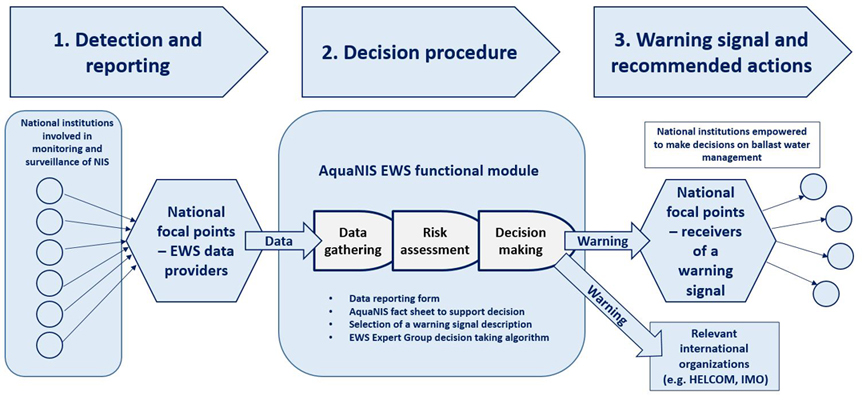The Early Warning System Concept
A regionally harmonized Early Warning System (EWS) for timely communication of findings of Harmful Aquatic Organisms and Pathogens (HAOP1) has been developed for the Baltic Sea area in accordance with the International Convention on the control and management of ships’ ballast water and sediments (International Maritime Organisation, 2004).

The aim of the EWS is to reduce the risk of spreading HAOP by minimizing the uptake and discharge of ballast water which could be harmful to the recipient port or area. This is achieved by issuing a warning signal to (1) vessels to prevent loading of ballast water when critical biological conditions occur in ports and surrounding areas, i.e. mass development or blooms of HAOP, and to (2) environmental and health authorities when Target Species2 or other organisms, which can be identified as HAOP, are present in ports or port vicinity to enable early response and implementation of remediation measures.
Detection and reporting. EWS Data Providers designated by Member States are responsible for receiving data from their national authorities in a timely manner and are authorized to use the AquaNIS EWS platform to report a HAOP detection to the EWS Expert Group.
Decision procedure. Members of the EWS Expert Group are designated by Member States. Upon receipt of a HAOP detection report and based on analysis of additional AquaNIS information, they decide whether to send an alert to their national authorities.
Warning signal and recommended actions. The alert is sent to all registered recipients designated by Member States as national focal points (eg port state control authorities, ministries of transport or environment). Once signaled, focal points decide what action to take. Decisions are made at the local level on a case-by-case basis, taking into account national regulations.
Definitions
- 1Harmful aquatic organisms and pathogens (HAOP). Aquatic organisms or pathogens which, if introduced into the sea including estuaries, or into fresh water courses, may create hazards to the environment, human health, property or resources, impair biological diversity or interfere with other legitimate uses of such areas (IMO, International Convention on the control and management of ships’ ballast water and sediments. International Maritime Organisation. 2004).
- 2Target Species (TS). Aquatic organisms or pathogens which, if introduced into the sea including estuaries, or into fresh water courses, may create hazards to the environment, human health, property or resources, impair biological diversity or interfere with other legitimate uses of such areas (IMO, Guidelines for risk assessment under regulation A-4 of the BWM Convention, 2007). The TS list for the Baltic Sea region is being continuously revised and updated by a dedicated Correspondence Group (document 3-4 to HELCOM/OSPAR TG BALLAST 9-2018).